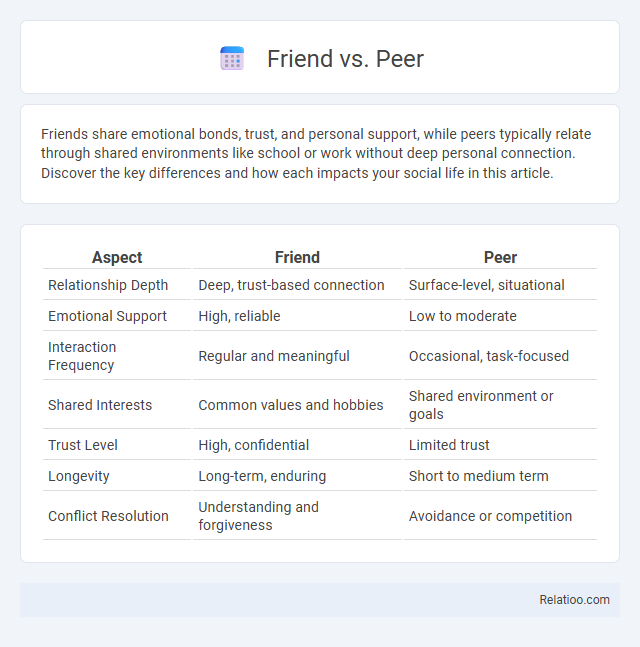Friends share emotional bonds, trust, and personal support, while peers typically relate through shared environments like school or work without deep personal connection. Discover the key differences and how each impacts your social life in this article.
Table of Comparison
| Aspect | Friend | Peer |
|---|---|---|
| Relationship Depth | Deep, trust-based connection | Surface-level, situational |
| Emotional Support | High, reliable | Low to moderate |
| Interaction Frequency | Regular and meaningful | Occasional, task-focused |
| Shared Interests | Common values and hobbies | Shared environment or goals |
| Trust Level | High, confidential | Limited trust |
| Longevity | Long-term, enduring | Short to medium term |
| Conflict Resolution | Understanding and forgiveness | Avoidance or competition |
Defining "Friend" and "Peer
A friend is someone with whom you share a close, trusting relationship based on mutual affection and support, often characterized by emotional bonds and personal experiences. A peer, in contrast, is an individual who belongs to the same social group, age group, or professional category as you, without the inherent emotional connection that defines friendship. Understanding these distinctions helps you navigate social dynamics by recognizing when interactions involve genuine friendship versus mere peer association.
Key Differences Between Friends and Peers
Friends share emotional bonds, trust, and mutual support, often involving deeper personal connections and long-term relationships. Peers refer to individuals of similar age, status, or social group, typically interacting in structured environments like school or work without necessarily forming close emotional ties. The key difference lies in the depth of interaction: friends engage in meaningful, supportive relationships, whereas peers mainly represent social or professional equals without guaranteed emotional closeness.
The Role of Trust in Friendship
Trust plays a crucial role in distinguishing friendship from peer relationships, as friendships are built on mutual confidence, emotional support, and reliability. While peers may share common environments or goals, your true friends provide a safe space for vulnerability and consistent honesty. Establishing trust in friendships fosters deeper connections and long-lasting bonds compared to casual peer interactions.
Social Boundaries: Peer Relationships
Peer relationships often involve individuals of similar age or status, creating a foundation for social interaction but maintaining clear social boundaries that limit emotional depth. Friends share stronger emotional connections and trust, often crossing social boundaries to form more intimate and supportive bonds. Understanding the distinctions in social boundaries helps clarify the roles peers play in everyday social development versus the deeper influence that friends exert on personal growth.
Emotional Support: Friends vs. Peers
Friends provide deeper emotional support through trust, empathy, and shared experiences, fostering a safe environment for expressing vulnerabilities. Peers offer companionship and understanding based on common activities or environments but may lack the emotional depth found in close friendships. When seeking genuine emotional support, your friends are more likely to respond with meaningful encouragement and comfort compared to casual peers.
Influence on Personal Growth
Friends significantly impact your personal growth by offering emotional support and shared experiences that foster self-awareness and confidence. Peers influence development through social comparison and competition, encouraging skill-building and motivation in academic or professional settings. While friends nurture emotional intelligence, peer influence often drives behavioral adaptation and goal-oriented progress.
Friendship and Peer Pressure
Friendship is built on mutual trust, support, and shared values, fostering positive emotional connections, while peer relationships primarily involve individuals of similar age or status, which may not always result in deep bonds. Peer pressure occurs when individuals in a peer group influence one another, often compelling behavior change to conform to group norms, which can be positive or negative. Understanding the dynamics between friends and peers helps recognize how friendship can buffer negative peer pressure and promote healthy social development.
Navigating Conflicts in Friendships and Peer Groups
Navigating conflicts in friendships requires empathy and open communication, allowing you to maintain trust and mutual respect even during disagreements. Peer conflicts often involve group dynamics and social status, so understanding peer pressure and practicing assertiveness can help resolve tensions effectively. Your ability to balance personal values with social harmony is key to managing issues in both friend and peer relationships.
Building Lasting Friendships from Peer Connections
Building lasting friendships from peer connections requires genuine communication, trust, and shared experiences beyond superficial interactions. While peers provide the initial social framework, transforming these connections into true friends depends on consistent support and mutual understanding. You can deepen peer relationships by prioritizing empathy and investing time in meaningful activities that foster emotional bonds.
Choosing Friends Among Peers
Choosing friends among peers involves evaluating shared values, trustworthiness, and emotional support beyond mere acquaintance. Friends provide deeper connection and mutual understanding compared to peers, who may only share similar environments or interests. Prioritizing quality and compatibility in friendships enhances social well-being and personal growth.

Infographic: Friend vs Peer
 relatioo.com
relatioo.com